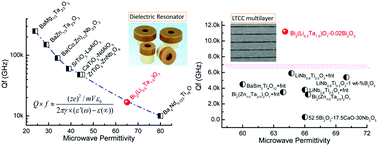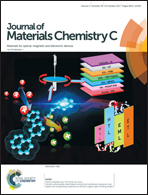High permittivity and low loss microwave dielectrics suitable for 5G resonators and low temperature co-fired ceramic architecture†
Abstract
Bi2(Li0.5Ta1.5)O7 + xBi2O3 (x = 0, 0.01 and 0.02) ceramics were prepared using a solid state reaction method. All compositions were crystallized in a single Bi2(Li0.5Ta1.5)O7 phase without secondary peaks in X-ray diffraction patterns. Bi2(Li0.5Ta1.5)O7 ceramics were densified at 1025 °C with a permittivity (εr) of ∼ 65.1, Qf ∼ 15 500 GHz (Q ∼ microwave quality factor; f ∼ resonant frequency; 16 780 GHz when annealed in O2) and the temperature coefficient of resonant frequency (TCF) was ∼ −17.5 ppm °C−1. The sintering temperature was lowered to ∼920 °C by the addition of 2 mol% excess Bi2O3 (εr ∼ 64.1, a Qf ∼ 11 200 GHz/11 650 GHz when annealed in O2 and at a TCF of ∼ −19 ppm °C−1) with compositions chemically compatible with Ag electrodes. Bi2(Li0.5Ta1.5)O7 + xBi2O3 are ideal for application as dielectric resonators in 5G mobile base station technology for which ceramics with 60 < εr < 70, high Qf and close to zero TCF are commercially unavailable. They may additionally prove to be useful as high εr and high Qf materials in low temperature co-fired ceramic (LTCC) technology.



 Please wait while we load your content...
Please wait while we load your content...